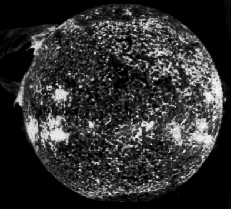Beginning in 1962, NASA launched a series of nine orbiting observatories to observe the Sun. Astrophysicists began to understand the interior of our nearest star. In the 1970s, Skylab astronauts brought back from orbit a wealth of data on the Sun, using x-rays to study its activity.
In 1978, one of the most successful astronom-ical
satellite missions, the International
Ultra-violet Explorer (IUE), was launched. This
satellite has an ultraviolet telescope that has

Final inflation of an instrument-carrying helium
balloon before launch from Palestine, TX

Skylab 4 picture of the Sun in ionized helium light
been used for more than 17 years to study the universe in the ultraviolet portion of the electromagnetic spectrum. Many scientists continue to use IUE simultaneously with other satellites and Earth telescopes to gather multi-wavelength data on astronomical objects.
Other NASA satellites have carried x-ray detectors into space. One of the first (1970)-- called Uhuru (Swahili for freedom)--mapped the entire sky in x-ray wavelengths. Later (1978) the second High Energy Astronomy Observatory (HEAO-2) called Einstein imaged many objects in x-ray light. Today a satellite called ROSAT (a name honoring the physicist who discovered x-rays, Dr. Roentgen) continues the study of individual sources of x-rays in the sky. All of these satellites added new objects to the astronomical zoo and helped scientists understand the processes that make x-rays in space. The sheer number of high energy objects discovered by these satellites surprised and excited the scientific community.
The Infrared Astronomical Satellite (IRAS) was launched in 1983. It mapped the sky in infrared wavelengths. IRAS scientists have discovered thousands of infrared sources never seen before. The infrared part of the spectrum tells about molecules in space and gas and dust clouds where new stars are hidden until they are bright enough to outshine their birth cloud.